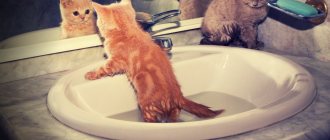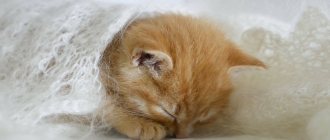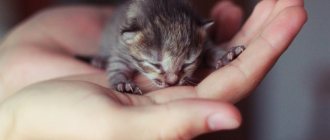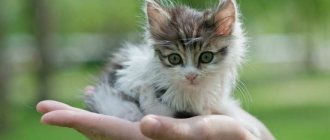Preparing a place for kittens
An ordinary bed will not work for small kittens - you will have to make a special house for the little ones. For such a house you will need a small box.
Place absorbent pads at the bottom of the box - disposable diapers from a pet store or children's department will do. Change diapers when dirty. Place fabric on the sides to make the kittens more comfortable.
To keep the kittens from freezing, place a heating pad wrapped in cloth in the nest. If you don't have a heating pad, use a warm water bottle instead. Update the heating pad so that the kittens' house remains warm.
Place the house in a dark place, as it is too early for babies to strain their eyes with light. At the same time, leave the box open to allow air to flow in.
Make sure that there are no drafts or temperature changes near the kittens' house - the nest should be warm. Try to maintain a temperature of 30 degrees during the first month of the kittens' life.
Socialization and games
The first contacts between children and kittens should be strictly under the supervision of adults. A small child perceives a pet as a toy and is capable of unknowingly causing him severe pain. Children aged 4–5 years need to be explained the rules for handling a new family member.
If there are other pets in the house, do not let them near the kitten right away. At first it is better to keep animals at a distance. Experienced owners advise locking them in different rooms and then switching places so that they get used to each other's smells.
A kitten is the same as a child, which means it needs affection and games. Take care in advance about purchasing cat toys: mice, balls, wigglers. If they are missing, it doesn’t matter either: the favorite of cats of any age is still a homemade device in the form of a rustling candy wrapper tied to a thin thread.
Biting is not allowed!
When playing, don't let your baby bite or scratch your hands. In nature, mother cats even lightly bite their playful cubs so that they come to their senses and behave decently. The owner, of course, has no right to bite, but he must stop the child who has crossed the border with the word “no” and stop the game for a while.
In conclusion, I would like to repeat that at the age of one month, a kitten is not yet ready to move to a new home. And when there is an opportunity to leave him next to his mother longer, it would be a sin not to take advantage of it.
Features of care
Remember that newborn kittens are very fragile - wrap the kitten in a towel if you want to handle it.
Mother cat licks little kittens not only for the sake of hygiene: babies do not yet know how to go to the toilet on their own, and they will need a little help with this.
After each feeding, take a cloth and lightly rub the kitten's tummy. Also massage under the ponytail. Continue until your baby goes to the toilet. Feces appear in kittens from 3-4 days of life - until then only clear liquid will be released.
From 3-4 weeks, kittens will learn to defecate on their own.
Normally, kittens urinate after every meal, defecation occurs 3-4 times a day.
In addition, each kitten needs to be brushed daily. Wipe entire kittens with a soft, damp cloth or cotton pad.
To make kittens feel loved, babies need to be gently stroked with a finger or a cloth. The cloth creates the illusion that the kitten is being licked by the mother.
Take kittens to the vet regularly
Your care for kittens also includes periodically showing them to a doctor, who will conduct a professional examination and give all the necessary vaccinations.
It is advisable to take your babies to the vet once a month, even if they feel well. You should immediately contact a specialist if you notice the following features:
- diarrhea or prolonged absence of bowel movements in the kitten;
- sneezing, as well as discharge from the nose and eyes;
- lack of appetite and lethargy;
- weight loss;
- nausea and vomiting;
- presence of injuries and bleeding in the kitten;
- elevated temperature (above 39°C).
By the way, if you have difficulty with some aspects of caring for a newborn kitten, you can always contact veterinarians or a shelter where stray animals are constantly cared for. And if you do not plan to keep the kitten, perhaps through a shelter you will be able to find new owners for your ward.
Healthy and beautiful kittens to you!
What to feed newborn kittens
Forget about the idea of feeding kittens cow's or goat's milk - the composition of such milk does not meet the needs of kittens. These types of milk contain less lactose, protein and fat, which will lead to problems in the development of kittens.
To feed small kittens, buy special milk replacers for kittens - that’s what they are called in pet stores. Instructions for diluting the mixture are indicated on the packaging.
You will also need special nipples and feeding bottles - some manufacturers include them with formulas. If they are not in the mixture, buy them at a pet store.
It is important to hold the kitten correctly when feeding - a newborn kitten should lie on its back with its head slightly raised. Your baby will begin to suck on the pacifier instinctively, but be careful not to throw his head back and choke.
If the kitten is coughing, remove the pacifier, turn the kitten head down and let it catch its breath. Older kittens will approach the bottle on their own.
When the baby began to fall asleep during feeding or milk bubbles appeared from his mouth, he was full. Gently wipe his face and put him to bed.
Babies eat 2-4 milliliters of mixture at a time every 2-3 hours. It is important to maintain a feeding schedule both day and night until the kittens are 3 weeks old. From the fourth week of life, kittens are fed only during the day.
| Age | Number of feedings | Mixture volume |
| 1 Week | 7 | 2-5 ml |
| 2 weeks | 6 | 5-10 ml |
| 3 weeks | 5 | 10-15 ml |
| 4 weeks | 5 | 10-20 ml |
| 5 weeks | 4 | 10-25 ml |
| 6 weeks | 4 | 10-25 ml |
Feeding with formula milk can be continued for up to 6 weeks, however, from the month of life, kittens should be gradually introduced into the diet. However, food for adult cats is not suitable - choose types of food with special labeling “for kittens”.
You can determine whether kittens are eating well by their behavior: well-fed babies sleep peacefully, while hungry ones squeak and suck the finger extended to them.
When to start raising a kitten, how and what to teach it
The optimal age for parenting occurs immediately after the adaptation period. Be attentive to the kitten's habits if it is more than 3 months old. It is extremely important to correct your pet’s behavior gently, in a playful or rewarding way . Don’t even think about hitting a kitten for training purposes; this will make your pet more nervous and timid, but not at all obedient. Avoid stressful situations until the kitten is 6 months old:
- Frequent arrivals of guests, noisy parties or celebrations. Yes, it is a sacrifice, but it is made to strengthen your pet's psyche.
- Walking on a leash is of no use to the baby; he needs to fully explore the home, every cabinet and every shelf. In addition, a pet that has not received vaccination should not come into contact with street animals, as this is fraught with viral diseases, sometimes fatal.
- Punishment - at this age, the kitten is very pliable and its behavior must be corrected exclusively with positive motivation.
Cats are very receptive to training up to a year , this period is quite enough to master basic skills. The first priority is litter box training . On the very first day, keep an eye on the baby, as soon as he starts to “fumble” in search of the toilet, transfer him to the tray. If you don't have time, quickly blot up the puddle with a paper napkin and place it in the tray. Even 2-month-old kittens have a keen sense of smell and rely on it when searching for a litter box.
Important! If you have multiple cats in your home, get extra litter boxes! Firstly, each pet should have its own toilet, and secondly, do not forget that some cats go to different litter boxes - big and small.
Try to take the kitten to the toilet 15–20 minutes after feeding and stay with the baby until he relieves himself. It is worth refraining from frequent cleaning of the tray, since fresh litter does not have a characteristic odor. Keep the trophy napkin (or replace it with a piece of cloth), praise your ward every time until the habit of going to the litter box is established.
Milk substitutes and formulas
Milk substitutes and milk formulas for animals or infants are the best option for feeding kittens left without a cat. They can be purchased at a veterinary pharmacy, veterinary clinic or pet store.
Advice! Give preference to products from well-known brands and brands. If you find it difficult to choose, consult with your veterinarian regarding the choice of artificial nutrition for orphaned kittens.
A high-quality substitute has a composition that is almost similar to the milk of a lactating female. It contains proteins, carbohydrates, vitamins, amino acids, and other useful substances for the development of small kittens.
Feeding formulas can be used for both kittens and infants. If necessary, below are recipes that are used to feed artificial kittens.
Industrial cat milk substitutes
There is a large selection of cat milk replacers in powder and liquid. Experts and veterinarians recommend products from the following brands and brands for bottle-fed kittens:
- Babycat Milk (Royal Canin). For feeding kittens from birth to 2 months.
- Katzenmilch. For feeding from the first days.
- Hartz.
- Gimpet Cat-Milk.
- Nurturall-C.
- Dolfos Dolmilk Cat.
- Beaphar Kitty milk.
Before preparing the mixture, carefully read the instructions on the package. The manufacturer indicates the approximate daily dose and preparation methods.
Industrial cat milk replacers for 2-week-old kittens are also used for feeding babies if the cat does not have enough milk. They are also recommended to be given to weakened pets who are not gaining weight well and to pregnant cats.
Infant milk formulas for kittens
For artificial kittens at two weeks of age, infant formula for kittens is also used. They can be purchased at any pet store. If you don’t have formula on hand, you can buy milk nutrition for infants at any pharmacy ( Nutrilon, Malyuk ). But dry formulations for kittens are diluted with twice as much water as indicated on the package.
First feeding
Starting from 3 weeks of age, kittens begin to be offered “adult” food. To avoid overloading the digestive tract, do this very carefully and gradually.
Unusual food is given little by little, starting with feeding once a day and increasing the number of complementary foods to 3 times a day over 7-10 days.
All food is given to babies in the form of warm puree.
Homemade food
You can start feeding small pets with natural protein products. The most suitable ones would be:
- Shaved veal. To obtain scraping, meat that has been frozen for 24-48 hours is scraped with a knife on a cutting board to form lamellar pieces. The initial size of the meat portion is comparable to the size of a pea.
- Baby meat puree in small jars.
- Liquid, well-cooked milk porridge (rice and oatmeal).
- Cream with a fat content of 9-10%.
- Fresh low-fat cottage cheese without additives.
Industrial rations
Special dry food and canned food are developed for small kittens in the 1st growth phase and ensure a safe transition from dairy food to adult food. They contain proteins, fats, vitamins and minerals that ensure the proper development of the kitten, but do not create a burden on the immature digestive system.
According to breeders, the leader in this area is Royal Canin Babycat 34.
Its small pieces have a delicate texture, quickly swell in water and turn into a nutritious paste.
Also watch the video on how to feed a newborn kitten without a cat:
Growth stages and needs of kittens from 0 to 30 days
In the first month, kittens experience processes of growth and development of the body; proper care during this period allows them to improve their health and avoid diseases in the future.
- The neonatal period lasts from the day the baby is born until 10 days. At this time, rapid noticeable changes in internal organs and external signs occur. Newborn kittens navigate thanks to two sensory systems - tactile and olfactory, since their eyes are closed and the auditory canal is not fully formed. Babies spend most of their time sleeping. Around the fifth day, the kitten begins to hear.
- The transitional stage begins at day 10 and lasts until day 20. At this time, kittens open their eyes, which means the central nervous system is maturing. It is believed that this stage is favorable for establishing good contact between the owner and the pet. Veterinarians recommend teaching your baby to hold hands. From the 10th day, the time spent with the owner should be about 4 minutes; as they grow older, the duration reaches 40 minutes a day. Regular communication with your pet is the key to a friendly relationship.
- The socialization stage begins when the baby takes his first steps. From this moment on, it is easier for the kitten to learn about the world around him. At the same time, the formation of the nervous system, adaptation mechanisms and socialization occurs.
Treatment for helminths
Little kittens must be protected from helminthiasis - diseases caused by the parasitism of various helminths in the animal's body, which release toxins and also mechanically damage tissues, causing inflammation. Characteristic signs of helminthiasis are diarrhea, sometimes with blood, vomiting, weight loss with increased appetite. Sometimes helminths can be seen in feces or vomit. Severe helminthic infestations are very dangerous for kittens and can be fatal. For prevention, kittens are dewormed every three months starting at 6 weeks of age. It is better to use well-proven drugs: Drontal, Profender, Milbemax strictly by weight.











